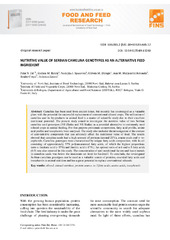Приказ основних података о документу
Nutritive value of Serbian camelina genotypes as an alternative feed ingredient
| dc.creator | Ilić, Petar | |
| dc.creator | Rakita, Slađana | |
| dc.creator | Spasevski, Nedeljka | |
| dc.creator | Đuragić Olivera, Olivera | |
| dc.creator | Marjanović-Jeromela, Ana | |
| dc.creator | Cvejić, Sandra | |
| dc.creator | Zanetti, Federica | |
| dc.date.accessioned | 2023-03-08T10:47:38Z | |
| dc.date.available | 2023-03-08T10:47:38Z | |
| dc.date.issued | 2022 | |
| dc.identifier.issn | 2217-5369 | |
| dc.identifier.uri | http://fiver.ifvcns.rs/handle/123456789/3334 | |
| dc.description.abstract | Camelina has been used from ancient times, but recently has re-emerged as a valuable plant with the potential for successful replacement of conventional oilseed crops. The utilisation of camelina and its by-products in animal feed is a matter of scientific study due to their excellent nutritional potential. The present study aimed to investigate the nutritive value of two Serbian camelina seed genotypes (NS Zlatka and NS Slatka) as a potential alternative to commonly used oilseed crops in animal feeding. For that purpose proximate composition, fatty acid profile, amino acid profile and tocopherols were analysed. The study also included the investigation of the content of anti-nutritive compounds that can adversely affect the nutritional value of feed. The results showed that camelina seeds had a high amount of proteins (around 28%), amino acids and γ- tocopherols. Camelina genotypes were characterized by unique fatty acids composition, with its oil consisting of approximately 57% polyunsaturated fatty acids, of which the highest proportions were α-linolenic acid (~37%) and linoleic acid (~17%). An optimal ratio of n-6 and n-3 fatty acids (0.5) was also reported in this study. The concentration of anti-nutritional factors and heavy metals in camelina seeds was below the maximum set limit for feedstuff. To conclude, the investigated Serbian camelina genotypes can be used as a valuable source of proteins, essential fatty acids and tocopherols in animal nutrition and has a great potential to replace conventional oilseeds | sr |
| dc.description.abstract | Lanik se gaji još od davnina, ali u poslednje vreme ponovo postaje predmet interesovanja zbog svog potencijala da zameni konvencionalne uljarice. Usled izvrsnog nutritivnog potencijala, iskorišćenje lanika i njegovih sporednih proizvoda prerade u hrani za životinje predstavlja predmet naučnih studija. Cilj ovog istraživanja bilo je ispitivanje nutritivne vrednosti semena dva srpska genotipa lanika (NS Zlatka i NS Slatka) kao potencijalne zamene uobičajeno korišćenih uljarica u ishrani životinja. U tu svrhu, rađene su analize hemijskog sastava, određivan je masnokiselinski i aminokiselinski profil kao i sadržaj tokoferola. Takođe, određivan je i sadržaj antinutritivnih materija koje mogu da umanje kvalitet hrane za životinje. Dobijeni rezultati su pokazali da seme lanika sadrži značajnu količinu proteina (oko 28%), aminokiselina i γ-tokoferola. Pokazano je da ispitivani genotipovi lanika poseduju karakterističan masnokiselinski sastav, pri čemu je ulje sadržalo oko 57% polinezasićenih masnih kiselina od kojih su najzastupljenije bile αlinolenska (~37%) i linolna (~17%) kiselina. Takođe je utvrđen i optimalni odnos n-6 i n3 masnih kiselina (0.5). Sadržaj antinutritivnih materija i teških metala u semenu lanika bio je ispod maksimalne dozvoljene granice za hranu za životinje. Zaključak ovog istraživanja je da se ispitani srpski genotipovi lanika mogu koristiti kao vredan izvor proteina, esencijalnih masnih kiselina i tokoferola u ishrani životinja, kao i da poseduju potencijal da postanu zamena konvencionalnih uljarica. | sr |
| dc.language.iso | en | sr |
| dc.publisher | Novi Sad : University of Novi Sad, Scientific Institute of Food Technology | sr |
| dc.relation | APV 142-451-2609/2021-01/02: Potencijal ulja od lanika i šafranike kao funkcionalnog dodatka u hrani za kućne ljubimce, financed by the Provincial Secretariat for Higher Education and Scientific Research, AP Vojvodina | sr |
| dc.relation | info:eu-repo/grantAgreement/MESTD/inst-2020/200222/RS// | sr |
| dc.rights | openAccess | sr |
| dc.rights.uri | https://creativecommons.org/licenses/by/4.0/ | |
| dc.source | Food and Feed Research | sr |
| dc.subject | oilseed | sr |
| dc.subject | animal nutrition | sr |
| dc.subject | protein source | sr |
| dc.subject | ω-3 fatty acids | sr |
| dc.subject | amino acids | sr |
| dc.subject | tocopherols | sr |
| dc.subject | uljarice | sr |
| dc.subject | ishrana životinja | sr |
| dc.subject | izvori proteina | sr |
| dc.subject | ω-3 masne kiseline | sr |
| dc.subject | aminokiseline | sr |
| dc.subject | tokoferoli | sr |
| dc.title | Nutritive value of Serbian camelina genotypes as an alternative feed ingredient | sr |
| dc.type | article | sr |
| dc.rights.license | BY | sr |
| dc.citation.epage | 221 | |
| dc.citation.issue | 2 | |
| dc.citation.rank | M24 | |
| dc.citation.spage | 209 | |
| dc.citation.volume | 49 | |
| dc.identifier.doi | 10.5937/ffr49-41060 | |
| dc.identifier.fulltext | http://fiver.ifvcns.rs/bitstream/id/9297/bitstream_9297.pdf | |
| dc.identifier.scopus | 2-s2.0-85153229103 | |
| dc.type.version | publishedVersion | sr |


